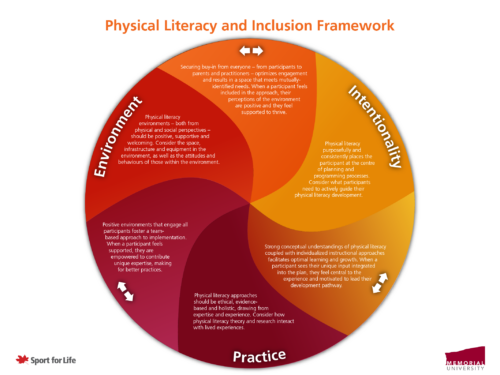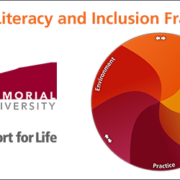Pillars to physical literacy and inclusion: Open-mindedness, adaptability, and willingness to evolve
Many programs have implemented physical literacy (PL) but often overlook the experiences of persons with diverse abilities due to societal, cultural, and political influences. This can lead to exclusion and marginalization from physical activities. Researchers at Memorial University have addressed this challenge by developing a PL and inclusion framework through direct observation of programming and perspectives from participants of diverse abilities, parents, practitioners, and program administrators. The framework and its three pillars of environment, practice and intentionality offer one lens to support the development of current and future inclusive physical literacy programs.

This blog series will discuss the ten evidence-based best practices for the inclusion of persons with diverse abilities in programming suggested within their research findings. From holistic design to systems of support, and everything in between, find out how to foster inclusion in your programs.
Idealization: Practitioners must maintain a willingness to evolve WITH participants, including an openness to learn about others and remaining flexible/adaptable in their instructional approach.
By adapting practices and learning based on real-time feedback and real events in their programming, practitioners can ensure each participant’s unique needs are met, fostering a successful and enjoyable learning experience.
Putting into practice
Meet Coach Taylor, a dedicated volunteer who leads an adaptive swimming program for individuals experiencing various disabilities. Taylor embodies the principle of evolving with participants and maintaining flexibility in their instructional approach to ensure long-term engagement in physical activity.
Coach Taylor recognizes that individuals with disabilities may have evolving needs and preferences. They commit to continuous learning and research to stay updated on inclusive swimming techniques.
Taylor regularly attends workshops and seminars on adaptive swimming and engages with experts in the field. They are open to exploring new teaching methods and adapting their coaching techniques to suit their participants’ changing requirements best.
Taylor takes an individualized approach to coaching. They understand that each participant has unique strengths and challenges, requiring personalized instruction. Taylor conducts thorough assessments with each participant to understand their goals and abilities. Based on this information, they customize swim drills and techniques to cater to their needs, ensuring everyone experiences progress and success.
Taylor actively seeks feedback from their participants. They understand the importance of their input in shaping the program’s direction. Taylor holds regular feedback sessions where participants can openly discuss their experiences and suggest improvements. They take their feedback seriously and implement changes to the program based on their input.
Taylor works closely with the swimming facility staff to ensure the environment is inclusive and adaptable. This may include making modifications to access ramps or providing adaptive equipment. They maintain a positive and collaborative relationship with the facility management. When participants require specific accommodations, they communicate their needs effectively to ensure a barrier-free swimming experience.
The adaptive swimming program thrives through Coach Taylor’s commitment to evolving with their participants, staying open to learning, and adapting their instructional approach. Participants not only engage in physical activity for the long term but also build confidence, experience personal growth, and develop a sense of belonging within the program. This example demonstrates how a volunteer community-based sport coach can ensure the principle of maintaining a willingness to evolve with participants, including openness to learn about others and remaining flexible and adaptable in their instructional approach. Such an approach fosters long-term engagement and inclusivity within the sports program for individuals experiencing disabilities.
Tangible takeaways
One of the best ways to enhance understanding is to think about these adaptations with real-world examples from programs. Using an activity from PLAYBuilder, Builders & Bulldozers, here is a firsthand glimpse of how flexibility and adaptability can transform a simple game into an inclusive and empowering experience for participants.
Example Activity: Builders and Bulldozers
Teams either stand up or knock over the cones in this competition.
Setup
- Divide participants into two teams – “builders” and “bulldozers.”
- Place cones randomly around the play space, with some facing upwards and some facing downwards.
Instructions & Cues
- On the signal, the Builders try and turn over the cones so they are standing upright, and the Bulldozers try and knock all the cones over.
- After a given time, count how many cones are up and down and declare a winner.
- Try another round and change the roles.
Adaptable Instructional Approach
- Time Flexibility: Remain flexible with the time for each round, adjusting it based on the participants’ energy and engagement to ensure the activity is appropriately challenging yet attainable for all.
- Team Size Consideration: Modify team sizes based on the number of participants to create balanced and inclusive teams. Ensure that everyone feels equally involved and empowered during the game.
- Dynamic Cone Placement: Change the arrangement of cones between rounds to introduce fresh challenges. Varying cone placements encourage problem-solving and adaptability, stimulating participants’ minds and bodies. Consider offering options for varying cone heights, using walls or other structures to cater to different abilities.
- Adaptive Equipment Accessibility: Be prepared with adaptive equipment to accommodate participants with diverse physical abilities. Providing the necessary resources ensures everyone can actively participate and enjoy the game.
- Rotating Roles and Collaborative Spirit: Encourage participants to switch roles between Builders and Bulldozers during the game. Additionally, promote teamwork and collaboration by introducing cooperative elements where participants work together towards shared objectives.
By incorporating adaptable instructional approaches like these into your programming and activities, we can create a dynamic and engaging experience that caters to the unique abilities of each participant.
Looking for more activities to support your programming? PLAYBuilder helps to bridge the knowledge gap surrounding physical literacy and quality sport—giving facilitators, program leaders and more the knowledge and confidence to deliver impactful programming. Learn more at getplaybuilder.ca.
This article is one of a series of posts on the Sport for Life website based on the research conducted by Drs. Kyle Pushkarenko and Jeff Crane of Memorial University. Keep an eye on our blog for information on the ten suggested best practices and ways to take action around them over the coming months.

